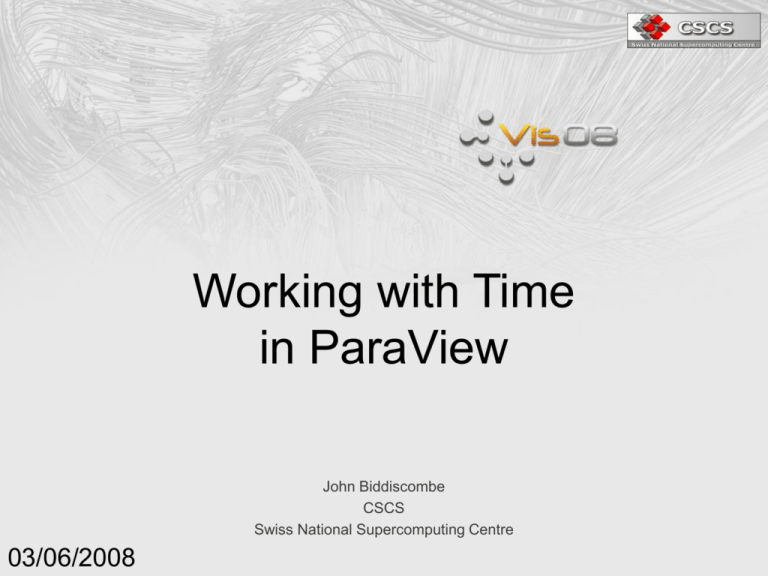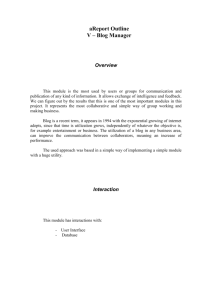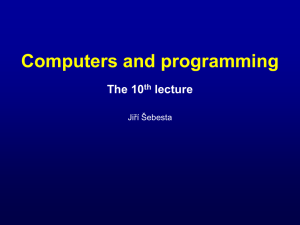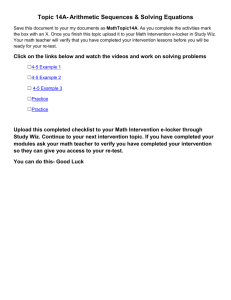IEEE08_Time-In
advertisement

Working with Time
in ParaView
John Biddiscombe
CSCS
Swiss National Supercomputing Centre
03/06/2008
Contents
Data Formats for time-dependent data
Overview of GUI controls
Animation Controls
Connection between GUI and internals
Comparative Visualization mode
Temporal Pipeline Overview
Time Dependent Filters (vtkTemporalXXX)
Manipulating Time in Filters (C++ code)…
Gotchas & Bugs
Future Plans
Data Import
Formats Supported
•
•
Exodus (used by several US research facilities)
vtkPVDReader (vtk XML Collection)
•
•
•
vtkFileSeriesReader
vtkXML * Reader
•
•
•
•
•
PolyData, UnstructuredGrid, StructuredGrid, ImageData, RectilinearGrid,
Multiblock, Heirarchical etc.
Legacy VTK files with 001, 002, 003 filenames
Ensight (case files, ASCII/Binary data)
OpenFOAM, SpyPlot, Phasta, STL, MFIX (untested by me)
Xdmf (extensible data model format)
•
•
•
filename.pvd + Filename-00.vtu/vti/vtp etc
XML light data with geometry/time information inside
Hdf5 – heavy – big data containing scalars/fields
(CSCS) custom readers include netCDF, H5Part (from CSCS web site)
Vtk (XML based) file format
VTK Collection - Easy to create by hand if necessary
A General purpose holder for vtk XML files of all types
vtu=unstructured, vtp=polydata, vtr=rectilinear, vti=imagedata
Each individual file can be binary/text, compressed or not
<VTKFile type="Collection" version="0.1" byte_order="LittleEndian">
<Collection>
<DataSet timestep="0.01" group="" part="0" file="Foo_001.vtu"/>
<DataSet timestep=“0.02" group="" part="0" file=“Foo_002.vtu"/>
<DataSet timestep=“0.03" group="" part="0" file=“Foo_003.vtu"/>
</Collection>
</VTKFile>
The VTK Collection is in fact a generic holder for MultiBlock composite datasets which
can store time information too.
The vtkXMLReader family is responsible for loading this kind of data.
User can use vtkXML_xxx_Writer to write N time steps of any kind of data and then
add a little XML meta data to describe it.
Caveat : pvd time collections are not working well in parallel (NxM split of blocks)
.pvd versus File List
• .pvd collection is a true Time compatible holder for data
• Time steps can be specified with real time values
• Don’t need to be contiguous or equally spaced
• FileSeriesReader : Selecting *.vtu/p/i/etc
•
•
•
•
•
•
•
simple but efficient way of loading time series
One step per file
Can’t specify true time values
vtkFileSeriesReader is clever
Load one – get one
Load *.ext, get time series
No C++ changes required to reader
vtkFileSeriesReader : make reader time aware
<FileSeriesReaderProxy
name="XMLUnstructuredGridReader"
class="vtkFileSeriesReader"
label="XML Unstructured Grid reader"
file_name_method="SetFileName">
<Documentation
short_help=“blah blah“
long_help=“ditto">
The XML Unstructured Grid reader reads the VTK XML
unstructured grid data file format. The standard
extension is .vtu.
This reader also supports file series.
</Documentation>
FileSeriesReader (slide 2)
Put details of your existing reader in ExposedProperties
<SubProxy>
<Proxy name="Reader"
proxygroup="internal_sources"
proxyname="XMLUnstructuredGridReaderCore">
</Proxy>
<ExposedProperties>
<Property name="CellArrayInfo" />
<Property name="CellArrayStatus" />
<Property name="PointArrayInfo" />
<Property name="PointArrayStatus" />
</ExposedProperties>
</SubProxy>
FileSeriesReader (slide 3)
<StringVectorProperty name="FileName"
clean_command="RemoveAllFileNames"
command="AddFileName"
animateable="0"
number_of_elements="0"
repeat_command="1">
<FileListDomain name="files"/>
<Documentation>
The list of files to be read by the reader. If more than 1
file is specified, the reader will switch to file series
mode in which it will pretend that it can support time
and provide 1 file per time step.
</Documentation>
</StringVectorProperty>
FileSeriesReader (slide 4)
The part which makes it ‘time aware’
<DoubleVectorProperty
name="TimestepValues"
information_only="1">
<TimeStepsInformationHelper/>
<Documentation>
Available timestep values.
</Documentation>
</DoubleVectorProperty>
</FileSeriesReaderProxy>
Old and New Time in ParaView
In PV2.x Time was generally animated by changing the TimeStep value of
a reader (or filter sometimes).
In PV3.x Time is an information variable/object passed down the pipeline
which makes it possible for filters to modify time before passing it to their
source. For this reason, the GUI sets the time inside the
Rendering/Mapping code and not via a TimeStep variable.
Some older (custom) readers may still have a TimeStep variable, but this is
being phased out and its use is not encouraged – unless you are trying to
do something ‘a bit special’ (see later slides).
Reader XML
For any reader
If you omit this (this is all you need in the XML)
Then you won’t see the time information.
<DoubleVectorProperty
name="TimestepValues"
information_only="1">
<TimeStepsInformationHelper/>
<Documentation>
Available timestep values.
</Documentation>
</DoubleVectorProperty>
It connects the TIME_STEPS key to the GUI
The old method (xml for reference)
<IntVectorProperty
name="TimeStep" command="SetTimeStep"
number_of_elements="1" default_values="0"
animateable="0"
information_property="TimestepValues">
<IntRangeDomain name="range">
<RequiredProperties>
<Property name="TimeStepRangeInfo" function="Range"/>
</RequiredProperties>
</IntRangeDomain>
<Documentation> Set the current timestep. </Documentation>
</IntVectorProperty>
And for convenience we usually provided a GetTimestepValues(vector)
C++ Reader : RequestInformation
Scan files/data structures and build a list/vector/array of times
Set TIME_STEPS for discrete time data (most readers really)
outInfo->Set(
vtkStreamingDemandDrivenPipeline::TIME_STEPS(),
&this->TimeStepValues[0], this->TimeStepValues.size());
Set TIME_RANGE if continuous, but can also be set for discrete
double timeRange[2];
timeRange[0] = this->TimeStepValues.front();
timeRange[1] = this->TimeStepValues.back();
outInfo->Set(
vtkStreamingDemandDrivenPipeline::TIME_RANGE(), timeRange, 2);
C++ Reader : RequestData
Find the correct time step (index into array of step values)
if (
outInfo->Has(vtkStreamingDemandDrivenPipeline::UPDATE_TIME_STEPS()))
{
// usually only one actual step requested
double requestedTimeValue = outInfo>Get(vtkStreamingDemandDrivenPipeline::UPDATE_TIME_STEPS())[0];
this->ActualTimeStep = vtkstd::find_if(
this->TimeStepValues.begin(), this->TimeStepValues.end(),
vtkstd::bind2nd( WithinTolerance( ), requestedTimeValue ))
- this->TimeStepValues.begin();
}
C++ Reader : RequestData
Time stamp the output DataObject using DATA_TIME_STEPS
output->GetInformation()->Set(vtkDataObject::DATA_TIME_STEPS(),
&requestedTimeValue, 1);
Nothing bad happens if you don’t – But filters which use the time
information won’t get what they need.
vtkTemporalPathLineFilter builds lists of data times for each frame and
joins the dots.
You can read the UPDATE_TIME_STEPS key, but it might not be the
same, and is strictly only present during RequestUpdateExtent
GUI Controls
Animating with Time
Animation GUI Controls
Time value displayed in toolbar –
Time step mode – user can change step
Sequence mode – user can change time
freely
VCR style toolbar has play controls
(play, step forward/back, jump to start/end)
Data with Time support shows the timesteps
in the information tab. (Lacks ability to click on
timestep and jump to it)
Animation control has settings for time
stepping and keyframes
Abort button to stop movie generation not
obvious
Time Modes in Animation Inspector
Snap to TimeSteps
When you click ‘play’ the animation will
begin at whatever time step you are
on and continue until it either reaches
the end (or is stopped manually).
When stopped the animation will continue
from where it left off if restarted.
Each frame played represents a single
time step of the input data
There is no need to set any keyframes or
specify any particular property to
animate.
The Track selection is used to select or
create keyframes
Time Modes in Animation Inspector
Snap to TimeSteps : * * * Warning * * *
When dataset 1 is loaded it may have time values
0, 1, 2, 3, …..N
When dataset 2 is loaded it may have time values
0.5, 1.5, 2.5, 3.5, …..M
Playing an animation in Snap To TimeSteps mode will traverse ALL
KNOWN Timesteps – which means
0, 0.5, 1, 1.5, 2, 2.5 …..max(M,N)
This can cause unexpected results!
Future time support should allow you to ‘Snap to active pipeline steps’
so that only the times exported for a particular dataset/filter will be
traversed. (In development).
Fix : Use Sequence mode and ‘lock’ the start and end times to prevent
changes
Time Modes in Animation Inspector
Sequence Mode
The start and end times correspond to the
max and min values of time in the data
you loaded.
If you manually change the start/end times
you can ‘Lock’ the new times – this
prevents them being reset to the
default start/end times if new data is
loaded.
Animation will now ignore the Time steps
present in the data and use
interval=(end/start)/(numFrames-1)
This is frequently NOT WHAT YOU WANT
Time Modes in Animation Inspector
Worked example
interval=(end/start)/(numFrames-1)
60.001424 - 50.001424 = 10
Num Frames = 10
We should get our original time steps back
(1s per step)
In fact we get 10/(numFrames-1) =
1.11111111s/frame
Need to use 11 frames to get
0,1,2,3,4,5,6,7,8,9,10
Note : In the some versions of PV3
selecting time values which are not
exactly the same as those present will
produce no update. It should snap to
the nearest time step, but does not.
See SnapToTimeSteps for a fix.
Time Modes in Animation Inspector
Real Time
Animates using the ‘Wall time’
Not always useful for the majority of
filters/data sources that we use
Useful to animate ‘as fast as we can’ if
data was stored with time representing
a real clock value and we wish to ‘play
back’ data in real time.
In this mode not all times may be
displayed. Some will be skipped or
some may be on screen for ages.
Could also be very handy for integrating
generators of data (eg sensor
equipment) into the gui and displaying
the real time update of the sensor (no
examples of this yet though)
Comparative visualization
Comparative View Inspector
• Allows MxN array of views on the same data
• Allows a variable to be changed along the X axis.
• Wrong - limitation <is> used to be that time must be between 0.0-1.0
for the view to operate
Solution :
TemporalShiftScale with
1/N scale factor
(or use Normalize flag set if
present in CVS)
Same Data at multiple T
Uses Time steps of
selected object
Avoid mismatched
time display in same
window.
FilmStrip uses X
Comparative : X&Y
Works, but patience
required
Comparative viz Summary
• Much easier than
•
•
•
•
•
Creating multiple windows manually
Setting up Shift/Scale
Instantiating Pipelines
Setting view/display properties
Can also use other plot styles.
Time Dependent Algorithms/Filters
Pipeline Introduction
Pipeline Introduction
The pipeline is demand driven with
data flowing downstream
Information flowing up and down stream
Data
Data source
filter(s)
Display/GUI
Renderer
UPDATE_TIME_STEPS
Information
In PV3 Time is part of the Information flow.
How does it work
• How does the pipeline actually fit together
• All filters are connected together by Executives which receive
information from downstream (and upstream) and decide
• Are the data inputs valid
• Are the data outputs valid
• Is everything else valid
• Has anything changed since I last updated
In PV3 Time is passed as information and the executives can
LOOP portions of the pipeline over multiple time steps
This means that filters can request multiple time steps
This enables us to implement Time Dependent Algorithms
Pipeline Looping
• vtkTemporalDataSet
• When the pipeline is looped to generate multiple time steps, the executive
generates a dataset collection
• The collection is passed to the temporal algorithm
• The algorithm can request any number of time steps
• But usually 2 (linear interpolation)
• In order to make looping work, some information keys are used internally
Information Keys
During Updates, the pipeline makes 4 request passes…
DataObject, Information, UpdateExtent, Data
Keys exported by time aware sources
TIME_RANGE (continuous), TIME_STEPS (discrete)
Time aware reader will declare N steps 0.0, 0.1, 0.2…..etc
Keys used during requests
UPDATE_TIME_STEPS (Filter says ‘I want these’)
Interpolator says I need times 0.1 and 0.2 for example
Keys set during execution
DATA_TIME_STEPS (Source says ‘I made these’)
Data generator says I generated times 0.1 and 0.2
Keys used internally by executives
REQUIRES_TIME_DOWNSTREAM (looping will be needed)
CONTINE_EXECUTING (multiple passes inside algorithm)
Time Dependent Algorithms/Filters
Interpolation
(Linear) Interpolation
• vtkTemporalInterpolator
• Linearly interpolates between 2 time steps
• When Time T.5 is requested it requests times T and T+1
• 2 Modes of Operation
• Continuous
• Discrete
• Continuous Mode
• DiscreteTimeStepInterval=0.0
• Filter generates no TIME_STEPS on output – just a TIME_RANGE
• GUI can request any time between min/max
• Discrete Mode
• DiscreteTimeStepInterval>0
• Filter generates (max-min)/DiscreteTimeStepInterval steps
• GUI sees discrete data with new TIME_STEPS values
(Linear) Interpolation
Continuous mode
Input data (left) has N discrete
time steps
Output data (right) has no time
steps
It does report a TIME_RANGE
So the GUI knows that any time
between min/max can be
requested
Interpolation – Continuous mode
Data Courtesy : David Graham, Plymouth UK.
(Linear) Interpolation
Discrete mode
Example :
DiscreteTimeStepInterval=0.01
New time steps are generated
and the output data ‘looks’ like it
has 10x as many time steps.
Note that no interpolation of the
data has been performed yet, only
when something is actually
rendered/requested will the
interpolation take place.
Interpolation – Discrete mode
(Linear) Interpolation
•
What can be interpolated
• Any Dataset which does not change topology between time steps
• Point positions are interpolated
• Connectivity (cells are copied)
• Point Data is interpolated
• Cell Data is interpolated
• ImageData/PolyData/Rectilinear/Unstructured
• All can be interpolated if cell connectivity and number of cells remains
the same
• MultiBlock/MultiGroup/Heirarchical/AMR
• If the tree structure remains the same between time steps and the
individual leaves satisfy above conditions
• Other interpolation methods could be added
Fixing Problems with the interpolator
• Discrete mode
• Given an input with N time steps, but a few are
accidentally missing (lost of never generated)
• Set DiscreteTimeStep Interval to the original time
step size (say 0.1 or 0.01 etc)
• Data saved every Nth frame to save IO time.
• Output now seems to be exactly the same as the
input – except that the steps that were missing
from the input are recreated using interpolation
when requested on the output
• Animate using ‘Snap To TimeSteps’ mode
• Animation will look like intended original
Problem Fixing Example (Interpolation)
Before
After
Missing data, low sampling
Problems for particle tracer
Lovely
Temporal DataSet Cache
Interpolation – Use a cache
If animation from 0->t is performed using a TemporalInterpolator, the
interpolator will request 2 time steps each time it updates
Interpolating at 0.1 spacing between 2 steps causes
Step 0 + Step 1 : Output Step 0.1
Step 0 + Step 1 : Output Step 0.2 Each step N times!
Step 0 + Step 1 : Output Step 0.3
Use a TemporalDataSetCache to store 2 timesteps and prevent this
repeated re-execution of the pipeline
Data source
(time aware)
TemporalDataSet
Cache
Interpolator
Display/GUI
Renderer
Branching Time – Use a cache
It’s not just the filter delivering the data at T, but the whole upstream
pipeline that is protected…
Consider the case where a pipeline branches and different T values are
requested. The cache prevents updates from one section propagating
too far upstream and forcing the other branch to be re-executed
needlessly.
Simple filter(s)
(no special time
requirements)
Data source
(time aware)
Temporal
DataSetCache
TemporalFilter
(requires multiple time
steps, e.g.. Particle tracer)
TemporalShiftScale
(modifies time values)
Display/GUI
Renderer
Branching Time – Caution in the GUI
When different values to T are visible/manipulated
Only display the leaf nodes of the pipeline
Rendering intermediate portions can trigger unwanted/confusing
updates
Display/GUI
Renderer
Simple filter(s)
(no special time
requirements)
UPDATE_TIME_STEPS
UPDATE_TIME_STEPS
Data source
(time aware)
Temporal
DataSetCache
TemporalFilter
(requires multiple time
steps, e.g.. Particle tracer)
TemporalShiftScale
(modifies time values)
Display/GUI
Renderer
Multiple Inputs
Related Cautionary Note #1
Multiple Inputs
• Time dependent filters with multiple inputs
• Trigger updates on all inputs
• Particle Tracer is one example
Avoid this.
Save Seeds
if possible
Data source
(time aware)
UPDATE_TIME_STEPS
Temporal
DataSetCache
UPDATE_TIME_STEPS
Slice – Seed Points
(for example)
Particle Tracer
Display/GUI
Renderer
Temporal Snap to TimeSteps
SnapToTimeSteps Example
Data source
(time aware)
TemporalDataSet
Cache
Interpolator
Time To Text
Snap To
TimeStep
Time To Text
Display/GUI
Renderer
Time Display Side note
Source : Time Source
Takes time from the UPDATE_TIME_STEPS
Actually it takes it directly from the view which is responsible for setting the
key on the filter/output
Filter->Temporal->Annotate Time
Takes its time from DATA_TIME_STEPS
Which is the actual time step output from the filter
The two might not always be the same (snap to timestep for example)
Time Shifting
Temporal Shift Scale
Changes time between the input and output of a filter
Can be used to compare the same data at 2 different values of T (though
the comparative viz view is easier to use in some ways)
Invaluable for combining different datasets with different T values
See example pipeline below
Tout = PreShift + Tin*Scale + PostShift
NB. +ve PostShift produces +ve delay of output time
seems the wrong way around
but time 0 is now time N, so it takes N seconds to get to it
Temporal Shift Scale
Pre-Shift = -50.0014
Scale = 1/10
Post-Shift = 3
Before
50-0014 - 60.0014
After
3.0 – 4.0
Developer Tip : Hiding bad time data
In RequestData
if (outInfo->Has(vtkStreamingDemandDrivenPipeline::UPDATE_TIME_STEPS())) {
double requestedTimeValue = outInfo->
Get(vtkStreamingDemandDrivenPipeline::UPDATE_TIME_STEPS())[0];
if (requestedTimeValue<this->TimeStepValues.front() ||
requestedTimeValue>this->TimeStepValues.back())
{
this->TimeOutOfRange = 1;
}
output->GetInformation()->Set(vtkDataObject::DATA_TIME_STEPS(),
&requestedTimeValue, 1);
}
…
if (this->TimeOutOfRange && this->MaskOutOfTimeRangeOutput) {
// don't do anything, just return success
return 1;
}
Developer Tip : Normalize Time
In RequestInformation
if (this->NormalizeToUnitTime && this->TimeStepValues.size()>0) {
double t1 = this->TimeStepValues.front();
double t2 = this->TimeStepValues.back();
double t3 = (t2-t1)>0 ? (1.0/(t2-t1)) : 1.0;
for (unsigned int i=0; i<this->TimeStepValues.size(); i++) {
double t = this->TimeStepValues[i];
this->TimeStepValues[i] = t3*(t-t1);
}
}
Then everything comes out {0,1}
Feature might be available in ShiftScale. Regional Variations
Comparative Vis (using Time shift)
• Time shift + Interpolation + Trails
• 3 time dependent features in 1 go
Temporal Shift Scale
Periodic Mode :
Turns N time steps spanning t time units into
N*T steps spanning T*t units
Periodic End Correction
If simulation steps are {0,1,2…N-1} and {N-1} is identical to {0}
Periodic end correction OFF = {0,1,2…N-1,1,2,3..N-1}
Otherwise {0,1,2…N-1,1,2,3..N-1} causes duplicated step
If simulation steps are {0,1,2…N-1} and {N-1} is different from {0}
Periodic end correction On
Otherwise {0,1,2…N-1,0,2,3..N-1} causes duplicated step
Periodic example
2 Separate Datasets
one 40 steps
one 80 steps
Duration 1s (approx)
Need 5+hours
80*3600*5 = 1.44E6
Tried 10,000 Periods in ParaView
(1 day?)
Need a better model!
Particle Tracer Pipeline (one nasty example)
Temporal
Cache
DataSet 1
PathLines
Particle Tracer
DataSet 2
Shift Scale
Interpolate
Temporal
Cache
Seeds 1
GUI
Seeds 2
Periodic Time + Resampling + Time Shift
Side Note : XML for Temporal Support
<SourceProxy name="TemporalSnapToTimeStep"
class="vtkTemporalSnapToTimeStep"
label="Temporal Snap-to-Time-Step">
<InputProperty name="Input" command="SetInputConnection">
<ProxyGroupDomain name="groups">
<Group name="sources"/>
<Group name="filters"/>
</ProxyGroupDomain>
<DataTypeDomain name="input_type" composite_data_supported="1">
<DataType value="vtkDataObject"/>
</DataTypeDomain>
</InputProperty>
Will change in future : no way of saying : DataType : PolyData : Temporal_required
Particle Tracer
TemporalStreamTracer
Particle Tracing
All Inputs must have same vector field
Multiple Multiblock Inputs supported (Temporal Required)
Meshes can be dynamic
Parallel operation
If input dataset has N time steps
Particle tracer will generate N-1 output steps
Output step 0 time value corresponds to input step {0,1} time
Nothing can be generated until 1 time period has passed
Seed points are supplied as separate inputs
Use SetTimeStep to combat odd time input combinations
Request Update Extent
for (int i=0; i<numInputs; i++) {
vtkInformation *inInfo = inputVector[0]->GetInformationObject(i);
// our output timestep T is timestep T+1 in the source
// so output inputTimeSteps[T], inputTimeSteps[T+1]
inInfo->
Set(vtkStreamingDemandDrivenPipeline::UPDATE_TIME_STEPS(),
&this->InputTimeValues[this->ActualTimeStep], 2);
vtkDebugMacro(<< "requested 2 time values : "
<< this->InputTimeValues[this->ActualTimeStep] << " "
<< this->InputTimeValues[this->ActualTimeStep+1]);
}
Particle Tracing (setup example)
Source (seedpoints)
LineSource 100 points
Time Step resolution
Leave as 1 – this can be
used to scale time if the input
time was not stored correctly
(e.g. it goes 0…N but should
be 0.1 0.2 0.3 etc)
Time Step (output index)
Set to zero initially – this will
request steps, (0,1) from the
input and the time actually
corresponds to T=1 (but it
will be the 0th step on the
output)
Particle Tracing
Force re-injection
every 1 or 2 time steps
Particles will be injected at the seed points every N
steps
Input vectors
Usually a velocity field, but could be another
Initial Integration step
Used by Runge-Kutta integration to make
incremental velocity field approximations
Can be smaller but 0.25 usually OK
Static Seeds - Static Mesh
Force optimizations
GEOMETRY_NOT_MODIFIED (work in progress)
Particle Tracing
Ignore pipeline time
This is very important – the particle tracer
generates less output steps than the input (-1) and
so we cannot (yet) use the default animation
controls due to bug mentioned earlier.
NB. This works now, but the comment is useful
We therefore instruct the particle tracer to ignore
pipeline time and instead animate the Timestep
property from 0 to N-2 (if the input has N steps,
the Particle tracer has N-1 steps output, so we go
from 0 to N-2 to get the correct number)
Particle filename (not shown)
An option to store particles to disk will be included
at a future date.
Side Note : Ignore Pipeline Time
if (this->IgnorePipelineTime) {
if (this->TimeStep<this->OutputTimeValues.size()) {
requestedTimeValue = this->OutputTimeValues[this->TimeStep];
} else {
requestedTimeValue = this->OutputTimeValues.back();
}
this->ActualTimeStep = this->TimeStep;
vtkDebugMacro(<< "SetTimeStep
: requestedTimeValue “
<< requestedTimeValue << " ActualTimeStep "
<< this->ActualTimeStep);
}
else {
the usual stuff to get requested time
}
Particle Tracing
To generate animation of particles
Use Sequence Mode Animation
Use N-1 Frames (because there will be N-1
steps generated – this data had 51 steps on
the input indexed as 0-50), so we use 50
frames for output
Create a Keyframe on ParticleTracer
TimeStep.
Set Keyframe index 0
Time to start time = 0.0 here
Value to TimeStep 0
Set Keyframe index 1
Time to end time = 7.99 in this example
Value to 49 (last index = 51-2)
Animation can now be played/saved as movie
Francis Turbine
PathLineFilter
Pathline Filter
• Connects to output of Particle tracer
• Can be used on any dataset with points (not just particles)
• Now supports selection of subset
• But needs to be updated to use vtkSelection type
• Uses Ids from selection dataset to choose points for line construction
• Is not strictly a vtkTemporalXXX filter because it does not loop time
• Listents to DATE_TIME_STEPS on input and builds list from that
• See other slides for example of usage
Plotting Data
over Time
Temporal Statistics
03/06/2008
Temporal Statistics
Computes
Mean
Min
Max
Standard Deviation
More can be added
Can take time!
Selection+Time
03/06/2008
Selection over time
• The same procedure can be used to query a particle over all available
time
• Extract Selection over time filter builds a spreadsheet of values for the
selected IDs over all time steps
• NB: Can’t set a sub region of time using the animation controls yet, but
this feature will be coming
• Selection tutorial should cover possible types
• Cell/Point/Global IDs can be used here
03/06/2008
Plot Selection over time
Which
Point
to
display
Which
field(s)
03/06/2008
Plot Selection over Time
Animations with
Non simple time
03/06/2008
How to animate a slice on a time-dependent dataset
Problem
When I try to animate, time changes as well as the slice
I can’t set time start/end to constants and then animate slice alone
ParaView hangs because of zero increment
Trying to fool it with tiny increments is not safe.
Show animation viewer and double click time track
Now animate the slice or other property using sequence mode
And keyframes to suit.
Demo 1
• How to animate a slice, and then animate the data?
Double click on
these tracks
Setup a slice keyframe
•
•
•
•
•
Create Slice offset keyframe
Animate a slice 50 frames one way
50 frames back again
Note that extents are +/- 1.5 = 3
Check values when adding keyframes
Change the Time track itself
• Double click Time track
•
•
•
•
Time is variable
It has its own keyframes
Fix time from frames 1-50
Animate time from 50 to 50+60
Sequence mode coordination
• Make sure the Animation inspector has the same information as the
animation viewer
• And….the keyframes
• When you add/remove them, or adjust the start/end time, they get
rescaled
• Could do with a ‘locking keyframe time’ option here
• The time here should be thought of as frames
Demo 2
Fixed, forward and reverse time in one animation
Animation
(frame) time
View (data)
time
We need tracks per dataset – to combine different
sources
Animate Camera from Python
phi = range(0, 360)
for i in phi:
view.CameraPosition = [2400*math.cos(i*math.pi*2.0/360),
2400*math.sin(i*math.pi*2.0/360), 300]
view.StillRender()
imgfile = "/path/to/snapshot.%03d.png" % i
view.WriteImage(imgfile, "vtkPNGWriter", 1)
To be Continued
Python versions of TimeAnimationCue, Scene, View
Exercise for the reader (Utkarsh) : recreate fancy time animations in
Python
Conclusion
Few Time dependent filters in ParaView so far
But …
Already powerful tool for animations/analysis
Animation improvements and time step handling will make it hard to beat
in terms of features and flexibility





